Inspectable Area: Units and Common Areas
Notes
| Chutes Damaged/Missing Components (Common Areas) |
| Deficiency: The structure that directs garbage into the appropriate storage container is missing or damaged. This includes the chute, chute door, and other components. |
| Note: Do not evaluate the door that leads to the trash room. |
| Level of Deficiency: |
| - Level 1: N/A |
| - Level 2: Garbage has backed up into chutes, because the collection structure is missing or broken. Compactors or components, chute, chute door, and other components, have failed. |
| - Level 3: N/A |
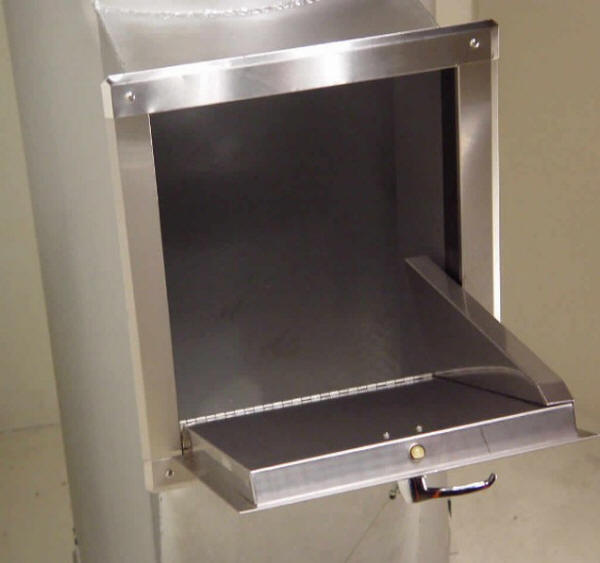
Old trash chute doors can become a nuisance, and they so frequently fail to work that it becomes a very routine thing, and gets forgotten.
It's a 1 to 2 point deduction if this is cited as Level 3
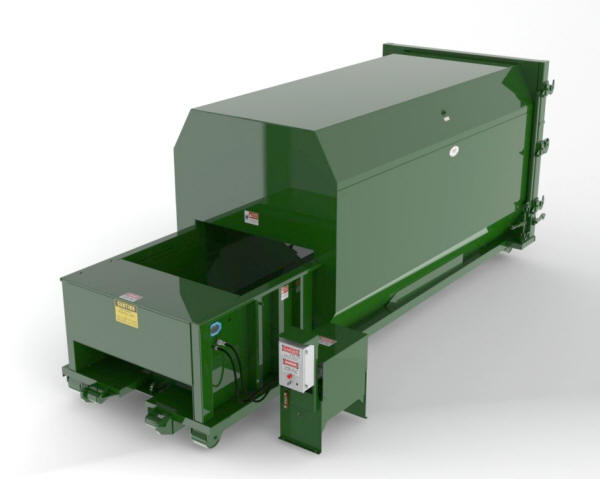
For example: there is one Unit/CA HVAC issue that does not exist at the Bldg Systems level, it can only be cited as a Unit/CA issue - see below:
| Convection/Radiant Heat System Covers Missing/Damaged (HVAC—Unit) |
| Deficiency: A cover on the convection/radiant heat system is missing or damaged, which could cause a burn or related injury. |
| Level of Deficiency: |
| - Level 1: N/A |
| - Level 2: N/A |
| - Level 3: At least 1 cover is missing or substantially damaged, allowing contact with heating/surface elements or associated fans. |
| Comment: |
| - Level 3: When the system is operational during an inspection and you see a Level 3 deficiency, a real-time hazard exists, you must record it manually under “Hazards (Health and Safety).” |
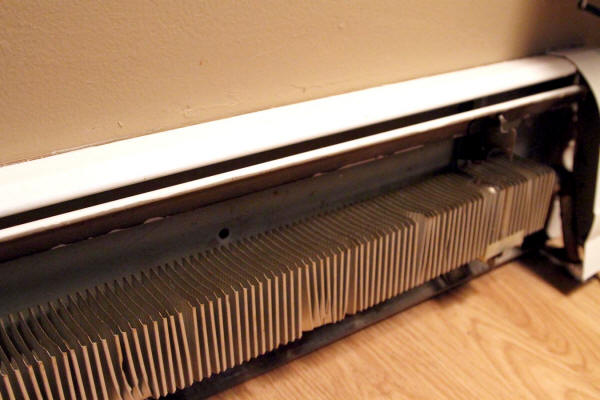
The scoring value is surprisingly high compared to some other defects - but that's not the worst of this . . .
This is also often cited as a Sharp Edges hazard for an additional point deduction, so that a missing or damaged baseboard heater cover can end up costing MORE than a full point in deductions.
| Plumbing—Clogged Drains (Bathroom—Unit) |
| Deficiency: Water does not drain adequately in the shower, tub, or basin (sink). |
| Level of Deficiency: |
| - Level 1: Water does not drain freely, but the fixtures can be used. |
| - Level 2: N/A |
| - Level 3: The fixtures are not usable, because the drain is completely clogged or shows extensive deterioration. |

A slow drain is Level 1.
A stopped drain is Level 3.
How slowly does it have to drain, in order to call it Level 3?
This is pretty much left up to inspector judgment.
| Plumbing—Leaking Faucet/Pipes (Bathroom—Unit) |
| Deficiency: You see that a basin, shower, water closet, tub faucet, or associated pipes are leaking water. |
| Level of Deficiency: |
| - Level 1: You see a leak or drip that is contained by the basin, and the faucet or pipe can be used. |
| - Level 2: N/A |
| - Level 3: You see a steady leak that is adversely affecting the area around it. |
| -OR- |
| The faucet or pipe cannot be used. |
"Cannot be used" means without creating a problem... like "adversely affecting the area around it."
If the water goes down the drain, it is a Level 1 leak...
UNLESS it then goes somewhere else, like on to the floor or into this bucket!
Now it is Level 3
| Lavatory Sink—Damaged/Missing (Bathroom—Unit) |
| Deficiency: A basin (sink) is missing or shows signs of deterioration or distress. |
| Note: If you see the stopper near the sink area, do not record it as a deficiency. |
| Level of Deficiency: |
| - Level 1: The sink can be used, but you see either of these: |
| —There are cracks or extensive discoloration in more than 50% of the basin; |
| -OR- |
| - A stopper is missing. |
| - Level 2: N/A |
| - Level 3: The sink cannot be used, because the sink or associated hardware is missing or has failed. |
Until recently it was held that a rubber stopper was a reasonable substitute for the original mechanical stopper, and that no defect should be cited if a rubber stopper was present.
More recent instructions from REAC say that this is still a defect if the plunger that operated the mechanical stopper is still present.
In other words: some inspectors will still cite this as Level 1 if the plunger is there or even if the little hole has not been filled.
The damage to the sink basin itself in this photo is not enough to cite.
| Water Closet/Toilet—Damaged/Clogged/Missing (Bathroom—Unit) |
| Deficiency: A water closet/toilet is damaged or missing. |
| Level of Deficiency: |
| - Level 1: N/A |
| - Level 2: Fixture elements, seat, flush handle, cover etc., are missing or damaged. |
| -OR- |
| The toilet seat is cracked, or the hinge is broken. |
| - Level 3: The bowl is fractured or broken and cannot retain water. |
| -OR- |
| The water closet/toilet is missing. |
| -OR- |
| There is a hazardous condition. |
| -OR- |
| The water closet/toilet cannot be flushed, because of obstruction or another defect. |
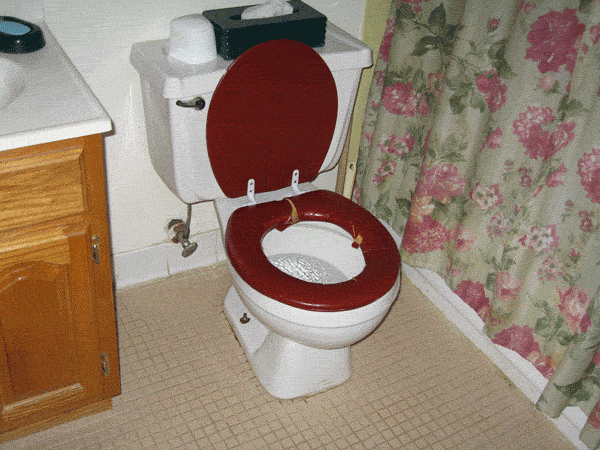
A loose seat would be Level 2.
Any missing or damaged part that still allows the toilet to be safely usable is Level 2.
If inoperable or unsafe, the toilet is Level 3.
Some say that a "running toilet" (leak at the fill valve) is a Level 2 Toilet defect. Others say it is a Level 1 Plumbing Leak.
The toilet defect is the higher scoring of the two, and the more common citation.
| Bathroom Cabinets—Damaged/Missing (Bathroom—Unit) |
| Deficiency: You see damaged or missing cabinets, vanity tops, drawers, shelves, doors, medicine cabinets, or vanities. |
| Level of Deficiency: |
| - Level 1: You see damaged or missing cabinets, vanity tops, drawers, shelves, doors, medicine cabinets or vanities that are not functioning as they should for storage or their intended purpose. |
| - Level 2: N/A |
| - Level 3: N/A |
| Plumbing—Leaking Faucet/Pipes (Bathroom—Unit) |
| Deficiency: You see that a basin, shower, water closet, tub faucet, or associated pipes are leaking water. |
| Level of Deficiency: |
| - Level 1: You see a leak or drip that is contained by the basin, and the faucet or pipe can be used. |
| - Level 2: N/A |
| - Level 3: You see a steady leak that is adversely affecting the area around it. |
| -OR- |
| The faucet or pipe cannot be used. |
| Shower/Tub—Damaged/Missing (Bathroom—Unit) |
| Deficiency: The shower, tub, or components are damaged or missing. This includes associated hardware, such as grab bars, shower doors, etc. |
| Note: |
| 1. This does not include leaking faucets and pipes. |
| 2. If you see the stopper near the shower/tub area, do not record it as a deficiency. |
| Level of Deficiency: |
| - Level 1: A stopper is missing. |
| - Level 2: The shower or tub can be used, but you see cracks or extensive discoloration in more than 50% of the basin. |
| - Level 3: The shower or tub cannot be used for any reason. The shower, tub, faucets, drains, or associated hardware is missing or has failed. |
| Ventilation/Exhaust System—Inoperable (Bathroom—Unit) |
| Deficiency: The apparatus used to exhaust air has failed. |
| Note: |
| 1. If a resident has blocked an exhaust fan but it can function properly, do not record this as a deficiency. |
| 2. If a resident has disconnected a fan, consider it functional if it can be immediately reconnected for your inspection. |
| 3. If there was never a bathroom fan, do not record this as a deficiency. |
| Level of Deficiency: |
| - Level 1: N/A |
| - Level 2: An exhaust fan is not functioning. |
| -OR- |
| A bathroom window cannot be opened. |
| - Level 3: N/A |
Bathroom cabinet damage includes damage to vanity and/or medicine. Any damage what-so-ever is Level 1.
Leaks in Bathroom and well as Kitchen (two separate defects using similar definitions) are Level 1 if all the leaking water goes down the drain. They are Level 3 if the water goes anywhere else - onto the floor, under the cabinet, etc.
A missing stopper in the tub is Level 1 like the sink issue.
Damage that renders any function of the tub or shower inoperable or unsafe to use is Level 3.
An inoperable bath fan is Level 2 - but property staff may reconnect the fan if it is unplugged, to demonstrate that it is operable with no defect cited.
| Cabinets—Missing/Damaged (Kitchen—Unit) |
| Deficiency: Cabinets are missing or the laminate is separating. This includes cases, boxes, or pieces of furniture with drawers, shelves, or doors, primarily used for storage, mounted on walls or floors. |
| Level of Deficiency: |
| - Level 1: N/A |
| - Level 2: You see that 10% to 50% of the cabinets, doors, or shelves are missing or the laminate is separating. |
| - Level 3: You see that more than 50% of the cabinets, doors, or shelves are missing or the laminate is separating. |
It's the fashionable new "plywood look" complete with bar code stickers.
So, imagine that this door represents one of nine cabinet doors in total.
1 divided by 9 = 0.111 or 11% of the doors.
This would be a Level 2 defect.
If 5 of 9 doors were damaged, missing, or delaminating, 5 divided by 9 = 0.555 or 56%, enough to cite this at Level 3
| Dishwasher/Garbage Disposal—Inoperable (Kitchen—Unit) |
| Deficiency: A dishwasher or garbage disposal, if provided, does not function. |
| Level of Deficiency: |
| - Level 1: N/A |
| - Level 2: The dishwasher or garbage disposal does not function. |
| - Level 3: N/A |
There is only one defect whether one or both is inoperable
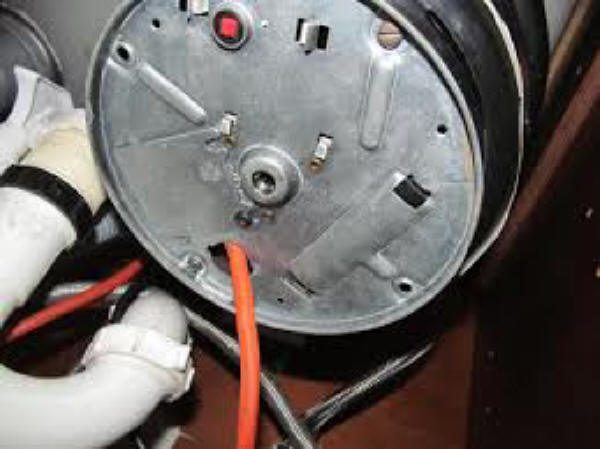
We have seen properties were every single disposal is improperly wired due to replacements being done by unqualified persons or by unscrupulous contractors cutting corners.
If the inoperable disposal was worth 0.2 points, the exposed wires hazard would be worth 1.6 points.
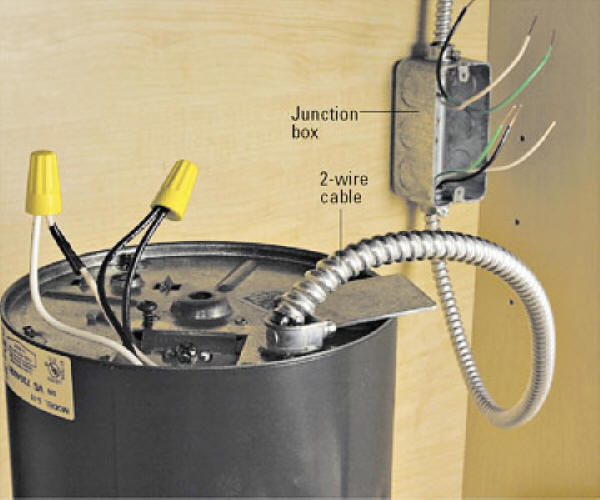
Imagine losing 32 points on disposal wiring alone!
Disposal wiring issues can be found at the cable connector (top photo,) at the junction box where wires come out of the wall or floor, or at the junction box built into the disposal itself.
All wiring should have proper wire nuts and should be inside a junction box with proper secured cover. There should be no gap that exposes connections.
| Range Hood/Exhaust Fans—Excessive Grease/Inoperable (Kitchen—Unit) |
| Deficiency: The apparatus that draws out cooking exhaust does not function. |
| Level of Deficiency: |
| - Level 1: An accumulation of dirt, grease or other barrier noticeably reduces the free passage of air. |
| - Level 2: N/A |
| - Level 3: The exhaust fan does not function. |
| -OR- |
| You estimate that the flue may be completely blocked. |
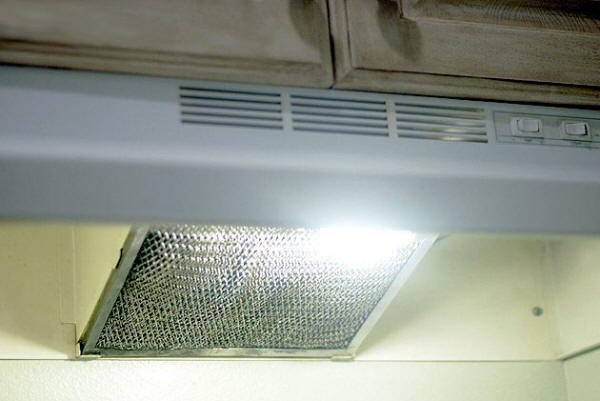
There is no specific defect in this photo
If the filter is dirty, it is Level 1
Until recently, a missing filter was NOT an exhaust fan issue, but many inspectors would cite it as Sharp Edges. (We often appeal that citation because the fan blades are not really sharp.)
As of mid 2016, REAC has instructed inspectors to cite as missing filter as Level 3 ! !
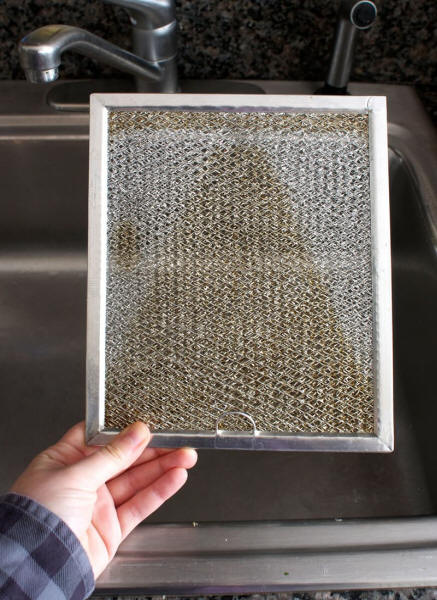
One very disturbing change in UPCS protocol - in our minds anyway - is that REAC is also now instructing inspectors to cite Exterior Walls, Damaged, Level 3, if the external cover of the kitchen or bathroom exhaust is damaged or missing.
| Range/Stove—Missing/Damaged/Inoperable (Kitchen—Unit) |
| Deficiency: The unit is missing or damaged. |
| Note: Before the inspection starts, you should be given a list of units under UFAS. Do not record these disconnected or partially disconnected ranges/stoves as a deficiency. |
| Level of Deficiency: |
| - Level 1: The operation of doors or drawers is impeded, but the stove is functioning. On gas ranges, flames are not distributed equally. The pilot light is out on 1 or more burners. |
| - Level 2: One burner is not functioning. |
| - Level 3: The unit is missing. |
| -OR- |
| Two or more burners are not functioning. |
| -OR- |
| The oven is not functioning. |
| Comment: |
| - Level 3: If this condition is a health and safety concern, you must record it manually under “Hazards (Health and Safety).” |
So often, a little bit of dirt clogging a burner port will prevent it from lighting.
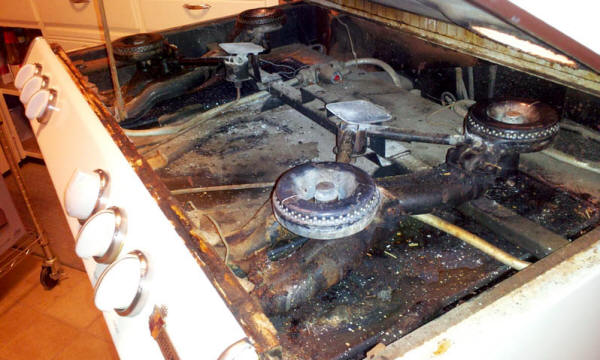
We once knew a property manager who told her residents that they "needed to make sure the top of their stoves were clean" in the notification letter she sent out to announce the inspection.
Many of the residents gave their stove a quick "wipe down" just as the inspector knocked on their door - and the quick sloppy wide-down crammed dirt into the burners. The property lost over 8 points that day, just for burner not lighting!
Two of the burners on this stove will not light - Level 3
(The top is just propped open, nothing is missing)
| Refrigerator—Missing/Damaged/Inoperable (Kitchen—Unit) |
| Deficiency: The refrigerator is missing or does not cool adequately for the safe storage of food. |
| Level of Deficiency: |
| - Level 1: The refrigerator has an excessive accumulation of ice. |
| -OR- |
| The seals around the doors are deteriorated. |
| - Level 2: N/A |
| - Level 3: The refrigerator is missing. |
| -OR- |
| The refrigerator does not cool adequately for the safe storage of food. |
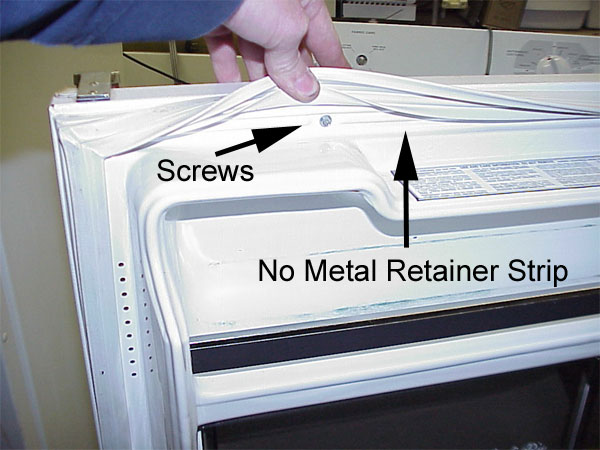
There is no specific defect in this photo
1 - It is present (not missing)
2 - It is cooling properly
3 - It is NOT iced up
4 - The gasket is not deteriorated
The refrigerator is NOT checked for:
Missing or broken handles, drawers, or shelves
Having been painted, dented, or otherwise cosmetic conditions
The scoring value of the refrigerator gasket is much lower than many people assume.
This defect gets more attention than it deserves in our opinion.
| Sink—Missing/Damaged (Kitchen—Unit) |
| Deficiency: A sink, faucet, or accessories are missing, damaged or not functioning. |
| Note: If a stopper is missing, do not record it as a deficiency. |
| Level of Deficiency: |
| - Level 1: You see extensive discoloration or cracks in 50% or more of the basin, but the sink and hardware can still be used to prepare food. |
| - Level 2: N/A |
| - Level 3: The sink or hardware is either missing or not functioning. |
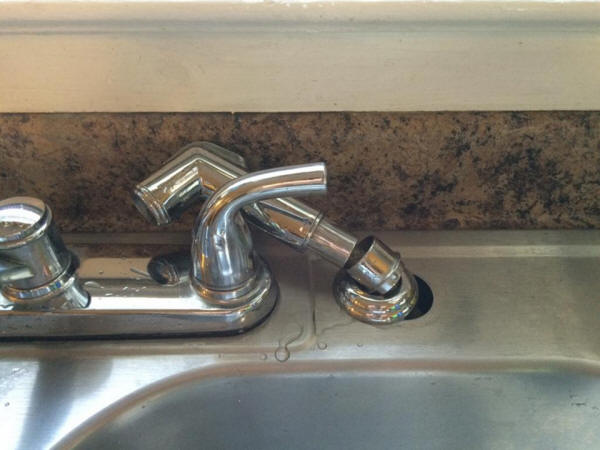
There is no specific defect in this photo
Missing handle: L3
Inoperable hot or cold water: L3
Clogged drain (separate defect)
Leaks (separate defect)
inoperable sprayer is NOT a defect - sprayers are only checked for leaks
sink stopper not checked in kitchen
| Countertops—Missing/Damaged (Kitchen—Unit) |
| Deficiency: A flat work surface in a kitchen often integral to lower cabinet space is missing or deteriorated. |
| Level of Deficiency: |
| - Level 1: N/A |
| - Level 2: 20% or more of the countertop working surface is missing, deteriorated, or damaged below the laminate and is not a sanitary surface on which to prepare food. |
| - Level 3: N/A |
| Plumbing—Clogged Drains (Kitchen—Unit) |
| Deficiency: The water does not drain adequately. |
| Level of Deficiency: |
| - Level 1: The basin does not drain freely. |
| - Level 2: N/A |
| - Level 3: The drain is completely clogged or has suffered extensive deterioration. |
| Plumbing—Leaking Faucets/Pipes (Kitchen—Unit) |
| Deficiency: You see that a basin faucet or drain connections leak. |
| Level of Deficiency: |
| - Level 1: You see a leak or drip that is contained by the basin or pipes, and the faucet is functioning as it should. |
| - Level 2: N/A |
| - Level 3: You see a steady leak that is having an adverse affect on the surrounding area, and the faucet or pipe is not usable. |
The Counter Top definition is very lenient! There must be severe damage (below the laminate) to 20% of the countertop before it is cited for a defect.
Clogged drains works just like it does in the bathroom.
Leaks works just like it does in the bathroom.
A drippy faucet with water going down the drain is Level 1
| Call-for-Aid—Inoperable (Unit) |
| System to summon help. May be visual, audible, or both. May be activated manually or automatically when pre-programmed conditions are met. |
| Deficiency: The system does not function. |
| Note: Inspector should verify that the Call-for-Aid only alerts local entities (on-site) prior to testing. |
| Level of Deficiency: |
| - Level 1: N/A |
| - Level 2: N/A |
| - Level 3: The system does not function. |
Yes, it is a safety device, and Yes, we need to keep these working as best we can.
However:
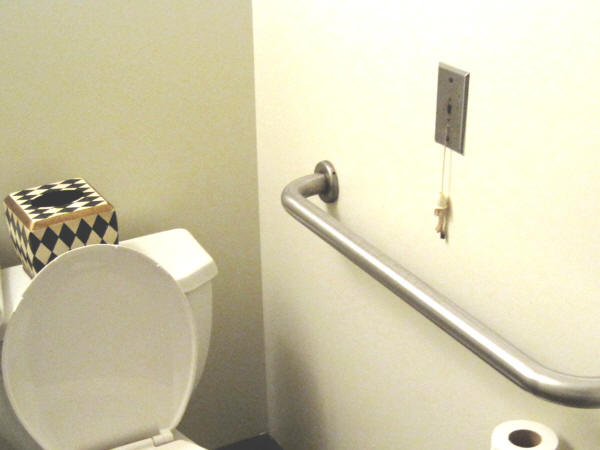
Yet, a single bad GFI in one Unit is worth an entire point, and these are often overlooked.
Setting good priorities for REAC preparations requires understanding the comparative scoring values of the individual defects.
And, YES, this is a Level 3 defect as pictured.
| Laundry Area/Room—Dryer Vent Missing/Damaged/Inoperable (Unit) |
| Place where soiled clothes and linens are washed and/or dried. |
| Deficiency: Inadequate means is available to vent accumulated heat/lint to the outside. The dryer vent is missing, damaged or inoperable. |
| Level of Deficiency: |
| - Level 1: N/A |
| - Level 2: N/A |
| - Level 3: Dryer vent is missing, damaged or is visually determined to be inoperable (blocked). Dryer exhaust is not effectively vented to the outside. |
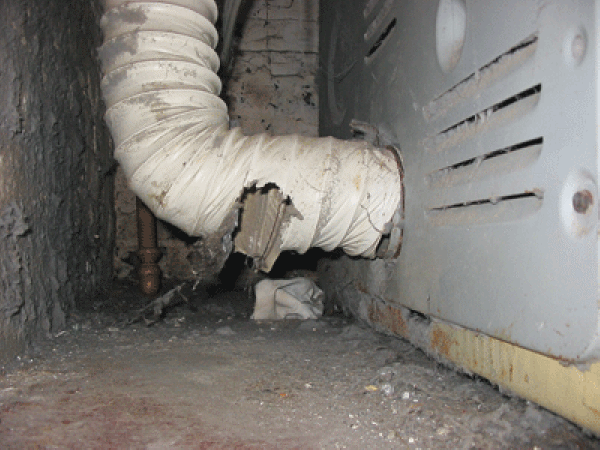
For a Common Area Laundry Room, when there is a single building, it can be worth 3 or 4 points - so check this!
It will count against your score even if the laundry equipment is maintained by a third party like a vending company!
| Stairs (Unit) |
| Series of 4 or more steps, or flights of steps, joined by landings connecting levels of a unit. Includes supports, frame, treads and handrails. |
| This inspectable item can have the following deficiencies: |
| Broken/Damaged/Missing Steps |
| Broken/Missing Hand Railing |
| Broken/Damaged/Missing Steps (Stairs—Unit) |
| Deficiency: The horizontal tread or stair surface is damaged or missing. |
| Level of Deficiency: |
| - Level 1: N/A |
| - Level 2: N/A |
| - Level 3: A step is broken or missing. |
| Broken/Missing Hand Railing (Stairs—Unit) |
| Deficiency: The handrail is damaged or missing. |
| Level of Deficiency: |
| - Level 1: N/A |
| - Level 2: N/A |
| - Level 3: The handrail for 4 or more stairs is either missing, damaged, loose or otherwise unusable. |
Steps means risers.
When counting steps, we count the risers to avoid semantic confusion between what is a "step" and what is a "landing."

This is a Level 3 defect.
If the rusty metal has a jagged edge, we might also have a Sharp Edges hazard.
| Smoke Detector—Missing/Inoperable (Unit) |
| Sensor to detect the presence of smoke and activate an alarm. May be battery operated or hard-wired to electrical system. May provide visual signal, audible signal or both. |
| Deficiency: A smoke detector will not activate or is missing. |
| Note: |
| 1. There must be at least 1 smoke detector on each level. |
| 2. If 2 or more smoke detectors are on the same level in visible proximity, at least 1 of the smoke detectors must function as it should. |
| Level of Deficiency: |
| - Level 1: N/A |
| - Level 2: N/A |
| - Level 3: A single smoke detector is missing or does not function as it should. |
Yes - as an "Exigent Health and Safety" issue, it requires immediate repair within 24 hours
No - you do NOT lose any points for this defect.
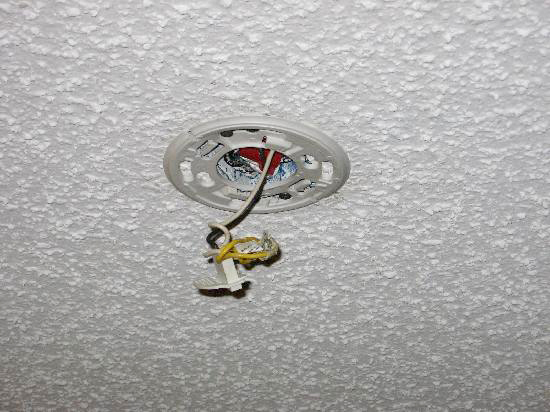
| Bulging/Buckling (Ceiling—Unit) |
| Deficiency: The ceiling is bowed, deflected, sagging, or is no longer aligned horizontally to the extent that ceiling failure is possible. |
| Level of Deficiency: |
| - Level 1: N/A |
| - Level 2: N/A |
| - Level 3: You see bulging, buckling, sagging, or a problem with alignment. |
| Comment: |
| - Level 3: If you as an inspector have concerns about the possibility of failure, inform the property representative that an inspection by a professional engineer is suggested. |
Compare to:
| Bulging/Buckling (Floors—Unit) |
| Deficiency: A floor is bowed, deflected, sagging, or is no longer aligned horizontally. |
| Level of Deficiency: |
| - Level 1: N/A |
| - Level 2: N/A |
| - Level 3: You see bulging, buckling, sagging, or a lack of horizontal alignment. |
| Comment: |
| - Level 3: If you have any doubt about the severity of this condition, request an inspection by a structural engineer. |
| Bulging/Buckling (Walls—Unit) |
| Deficiency: A wall is bowed, deflected, sagged or is no longer vertically aligned. |
| Level of Deficiency: |
| - Level 1: N/A |
| - Level 2: N/A |
| - Level 3: You see bulging, buckling, sagging, or that the wall is no longer vertically aligned. |
| Comment: |
| - Level 3: If you have any doubt about the severity of the condition, request an inspection by a structural engineer. |
- Ceilings
- Floors
- Walls
All have very similar defects.
All three of these structural surfaces can be cited for
Bulging/Buckling
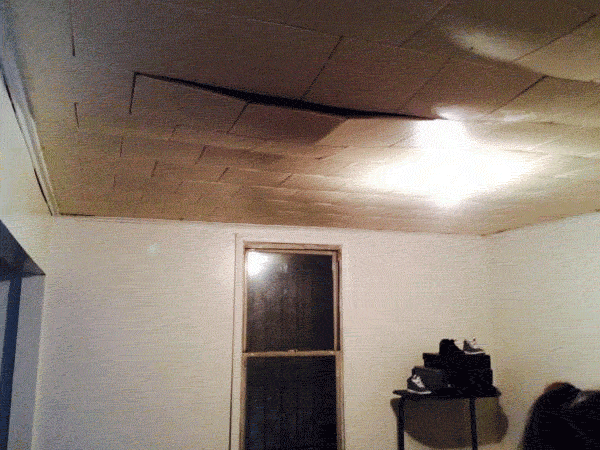
It can only be Level 3
| Peeling/Needs Paint (Walls—Unit) |
| Deficiency: |
| —Paint is peeling, cracking, flaking or otherwise deteriorated. |
| -OR- |
| —A surface is not painted. |
| Note: Before the inspection starts, you should be given a list of UFAS buildings/units. For the buildings/items on this list, do not record as deficiencies any superficial surface/paint damage caused by wheelchairs, walkers or medical devices. |
| Level of Deficiency: |
| - Level 1: The affected area affected is more than 1 square foot but less than 4 square feet. |
| - Level 2: The affected area is more than 4 square feet. |
| - Level 3: N/A |
Compare to:
| Peeling/Needs Paint (Ceiling—Unit) |
| Deficiency: |
| —You see paint that is peeling, cracking, flaking, or otherwise deteriorated. |
| -OR- |
| —You see a surface that is not painted. |
| Level of Deficiency: |
| - Level 1: The affected area is larger than 1 square foot, but smaller than 4 square feet. |
| - Level 2: The affected area is larger than 4 square feet. |
| - Level 3: N/A |
| Peeling/Needs Paint (Floors—Unit) |
| Deficiency: For floors that are painted, you see paint that is peeling, cracking, flaking, or otherwise deteriorated. |
| Level of Deficiency: |
| - Level 1: The area affected is more than 1 square foot, but less than 4 square feet. |
| - Level 2: The area affected is more than 4 square feet. |
| - Level 3: N/A |
- Ceilings
- Floors
- Walls
All have very similar defects.
All three of these structural surfaces can be cited for
Peeling/Needs Paint

If we go by the scoring value REAC places on paint in your Units,
the answer does not require one to paint for a REAC inspection
More than 4 square feet is Level 2
Study the point values on these issues.
(Assuming 2 points per Unit)
A Level 2 paint on each of the 3 Inspectable Items would be worth two one hundredths of one point.
Times 3 (ceiling, floor, wall) = 0.06
Times 20 units being inspected = 1.2 points - and that's at the greatest extreme possible.
Realistically, maybe 50% of your Units get cited for paint on a ceiling or wall. Let's say 10 times 0.02.
You would lose about 0.2 points on paint in your Units.
| Damaged (Walls—Unit) |
| Deficiency: You see cracks and/or punctures in the wall surface that may or may not penetrate completely. Panels or tiles may be missing or damaged. |
| Note: |
| 1. This does not include small holes created by hanging pictures, etc. |
| 2. Control joints/construction joints should not be recorded as a deficiency. |
| 3. Cracks that have been repaired or sealed properly should not be considered a deficiency. |
| Level of Deficiency: |
| - Level 1: In a wall, you find a hole, crack, missing tile or panel, or other damage that is between 1 square inch and 8 1/2 inches by 11 inches. The hole does not penetrate the adjoining room/area. You cannot see through it to the adjoining area. |
| -OR- |
| You find a crack greater than 1/8 inch wide and at least 11 inches long. |
| - Level 2: In a wall, you find a hole, missing tile or panel, or other damage that is larger than a sheet of paper, 8 1/2 inches by 11 inches, and does not penetrate the adjoining room. You cannot see through it to the adjoining area. |
| - Level 3: You find a hole of any size that penetrates an adjoining room. You can see through the hole. |
| -OR- |
| Two or more walls have Level 2 holes. |
| Comments: |
| - Level 3: If a hole or crack is a health and safety concern, you must record it manually under “Hazards (Health and Safety).” |
| If you as an inspector have concerns about the possibility of failure, inform the property representative that an inspection by a professional engineer is suggested. |
Compare to:
| Holes/Missing Tiles/Panels/Cracks (Ceiling—Unit) |
| Deficiency: |
| - The ceiling surface has punctures that may or may not penetrate completely. |
| -OR- |
| - Panels or tiles are missing or damaged. |
| Level of Deficiency: |
| - Level 1: You see small holes that are no larger than a sheet of paper, 8 1/2 inches by 11 inches. |
| -OR- |
| No hole or crack penetrates the area above. |
| -OR- |
| You see that no more than 3 tiles or panels are missing. |
| -OR- |
| You see a crack more than 1/8 inch wide and 11 inches long. |
| - Level 2: You see a hole that is larger than a sheet of paper, 8 1/2 inches by 11 inches, but it does not penetrate the area above. You cannot see through it. |
| -OR- |
| You see that more than 3 tiles or panels are missing. |
| -OR- |
| You see a crack more than 1/8 inch wide and 11 inches long. |
| - Level 3: You see a hole that penetrates the area above. You can see through it. |
| Comment: |
| - Level 3: If a hole or crack is a health and safety concern, you must record it manually under “Hazards (Health and Safety).” |
- Ceilings
- Walls
Both a very similar defects for general damage like holes or cracks.
While the exact NAME of the defects is different, the definitions are exactly the same for all practical purposes.
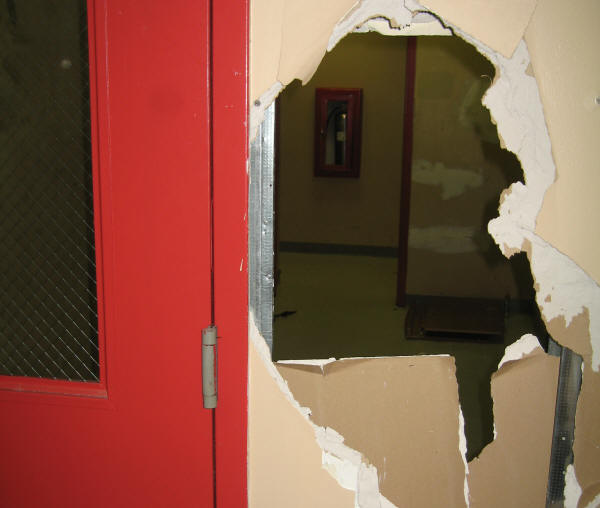
"You can se through it"
Level 3
| Soft Floor Covering Missing/Damage (Floors—Unit) |
| Deficiency: You see damaged and/or missing soft floor covering. |
| Level of Deficiency: |
| - Level 1: You estimate that only 5% to 10% of any single soft floor covering has stains, surface burns, shallow cuts, small holes, tears, loose areas, or exposed seams. The covering is fully functional, and there is no safety hazard. |
| - Level 2: You estimate that 10% to 50% of any single soft floor covering has burn marks, cuts, tears, holes, or large sections of exposed seams that expose the underlying material. There is no safety hazard. |
| - Level 3: You estimate that more than 50% of any single soft floor covering is damaged. |
| -OR- |
| Damage to the soft floor covering exposes the underlying material. |
| Comment: |
| - Level 3: If this condition is a health and safety concern, you must record it manually under “Hazards (Health and Safety).” |
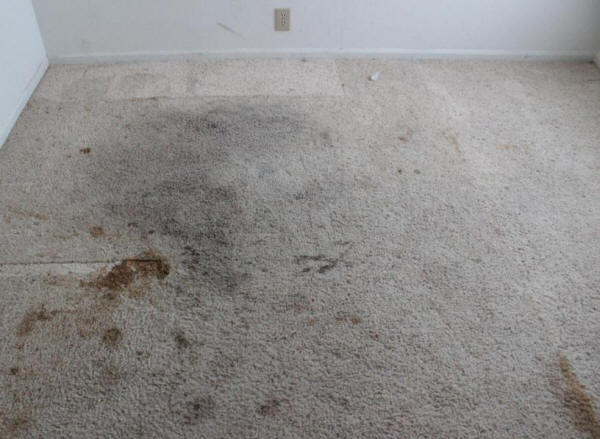
However, "dirty" and "stained" are different things.
It might be more reasonable to say that a little less than 10% of the carpet in this area is actually damaged or permanently stained - bringing this to a Level 1.
This is one of those cases were inspector judgment can make a very significant difference in the REAC score.
| Hard Floor Covering Missing/Damaged Flooring/Tiles (Floors—Unit) |
| Deficiency: You see that hard flooring, terrazzo, hardwood, ceramic tile, sheet vinyl, vinyl tiles, or other similar flooring material, is missing section(s), is missing, or presents a tripping or cutting hazard, associated with but not limited to holes or delamination. |
| Level of Deficiency: |
| - Level 1: For any single floor surface, you see deficiencies in areas of the floor surface. You estimate that 5% to 10% of the floor is affected, and there are no safety problems. |
| - Level 2: You estimate that 10% to 50% of any single floor surface is affected, but there are no safety problems. |
| - Level 3: You estimate that more than 50% of any single floor surface is affected by Level 1 deficiencies. |
| -OR- |
| The condition causes a safety problem. |
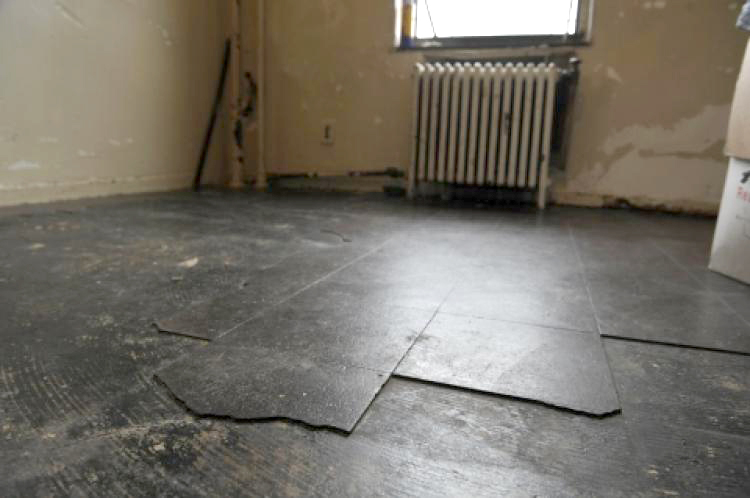
While it is hard to actually see and count the number of bad tiles in the photo, let's say just over 10% are damaged or missing in this room.
That would put us at Level 2.
| Damaged/Deteriorated Trim (Walls—Unit) |
| Deficiency: Cove molding, chair rail, base molding or other decorative trim is damaged or has decayed. |
| Note: Before the inspection starts, you should be given a list of UFAS buildings/units. For the buildings/units on this list, do not record superficial surface/paint damage caused by wheelchairs, walkers or medical devices as a deficiency. |
| Level of Deficiency: |
| - Level 1: You see small areas of deterioration in the trim surfaces, and you estimate that 5% to 10% of the wall area is affected. |
| - Level 2: You see large areas of deterioration in the trim surfaces, and you estimate that 10% to 50% of the wall area is affected. |
| - Level 3: You see significant areas of deterioration in the wall surfaces, and you estimate that more than 50% of the wall area is affected. |
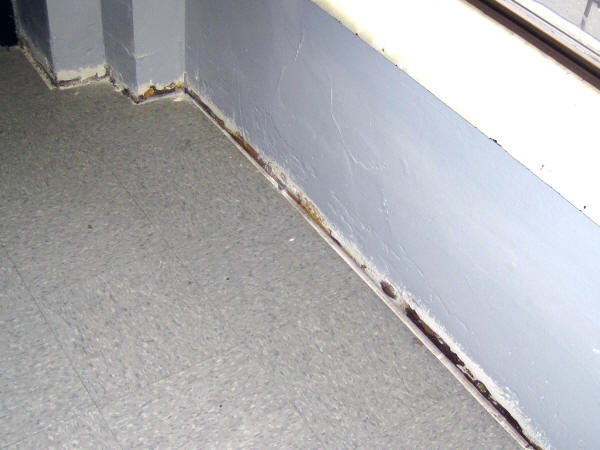
Mold/Mildew/Water Stains/Water Damage
(for Ceilings, Floors and Walls)
Rot/Deteriorating Subfloors
(for Floors)
| Unit Inspectable Items |
| Items to inspect for “Unit” are as follows: |
| Bathroom |
| Call-for-Aid |
| Ceiling |
| Doors |
| Electrical System |
| Floors |
| Hot Water Heater |
| HVAC System |
| Kitchen |
| Laundry Area |
| Lighting |
| Outlets/Switches |
| Patio/Porch/Balcony |
| Smoke Detector |
| Stairs |
| Walls |
| Windows |
| Bathroom (Unit) |
| A room equipped with a water closet or toilet, tub and/or shower, sink, cabinet(s) and/or closet. This inspectable item can have the following deficiencies: |
| Bathroom Cabinets—Damaged/Missing |
| Lavatory Sink—Damaged/Missing |
| Plumbing—Clogged Drains |
| Plumbing—Leaking Faucet/Pipes |
| Shower/Tub—Damaged/Missing |
| Ventilation/Exhaust System—Inoperable |
| Water Closet/Toilet—Damaged/Clogged/Missing |
| Bathroom Cabinets—Damaged/Missing (Bathroom—Unit) |
| Deficiency: You see damaged or missing cabinets, vanity tops, drawers, shelves, doors, medicine cabinets, or vanities. |
| Level of Deficiency: |
| - Level 1: You see damaged or missing cabinets, vanity tops, drawers, shelves, doors, medicine cabinets or vanities that are not functioning as they should for storage or their intended purpose. |
| - Level 2: N/A |
| - Level 3: N/A |
| Lavatory Sink—Damaged/Missing (Bathroom—Unit) |
| Deficiency: A basin (sink) is missing or shows signs of deterioration or distress. |
| Note: If you see the stopper near the sink area, do not record it as a deficiency. |
| Level of Deficiency: |
| - Level 1: The sink can be used, but you see either of these: |
| —There are cracks or extensive discoloration in more than 50% of the basin; |
| -OR- |
| - A stopper is missing. |
| - Level 2: N/A |
| - Level 3: The sink cannot be used, because the sink or associated hardware is missing or has failed. |
| Plumbing—Clogged Drains (Bathroom—Unit) |
| Deficiency: Water does not drain adequately in the shower, tub, or basin (sink). |
| Level of Deficiency: |
| - Level 1: Water does not drain freely, but the fixtures can be used. |
| - Level 2: N/A |
| - Level 3: The fixtures are not usable, because the drain is completely clogged or shows extensive deterioration. |
| Plumbing—Leaking Faucet/Pipes (Bathroom—Unit) |
| Deficiency: You see that a basin, shower, water closet, tub faucet, or associated pipes are leaking water. |
| Level of Deficiency: |
| - Level 1: You see a leak or drip that is contained by the basin, and the faucet or pipe can be used. |
| - Level 2: N/A |
| - Level 3: You see a steady leak that is adversely affecting the area around it. |
| -OR- |
| The faucet or pipe cannot be used. |
| Shower/Tub—Damaged/Missing (Bathroom—Unit) |
| Deficiency: The shower, tub, or components are damaged or missing. This includes associated hardware, such as grab bars, shower doors, etc. |
| Note: |
| 1. This does not include leaking faucets and pipes. |
| 2. If you see the stopper near the shower/tub area, do not record it as a deficiency. |
| Level of Deficiency: |
| - Level 1: A stopper is missing. |
| - Level 2: The shower or tub can be used, but you see cracks or extensive discoloration in more than 50% of the basin. |
| - Level 3: The shower or tub cannot be used for any reason. The shower, tub, faucets, drains, or associated hardware is missing or has failed. |
| Ventilation/Exhaust System—Inoperable (Bathroom—Unit) |
| Deficiency: The apparatus used to exhaust air has failed. |
| Note: |
| 1. If a resident has blocked an exhaust fan but it can function properly, do not record this as a deficiency. |
| 2. If a resident has disconnected a fan, consider it functional if it can be immediately reconnected for your inspection. |
| 3. If there was never a bathroom fan, do not record this as a deficiency. |
| Level of Deficiency: |
| - Level 1: N/A |
| - Level 2: An exhaust fan is not functioning. |
| -OR- |
| A bathroom window cannot be opened. |
| - Level 3: N/A |
| Water Closet/Toilet—Damaged/Clogged/Missing (Bathroom—Unit) |
| Deficiency: A water closet/toilet is damaged or missing. |
| Level of Deficiency: |
| - Level 1: N/A |
| - Level 2: Fixture elements, seat, flush handle, cover etc., are missing or damaged. |
| -OR- |
| The toilet seat is cracked, or the hinge is broken. |
| - Level 3: The bowl is fractured or broken and cannot retain water. |
| -OR- |
| The water closet/toilet is missing. |
| -OR- |
| There is a hazardous condition. |
| -OR- |
| The water closet/toilet cannot be flushed, because of obstruction or another defect. |
| Call-for-Aid—Inoperable (Unit) |
| System to summon help. May be visual, audible, or both. May be activated manually or automatically when pre-programmed conditions are met. |
| Deficiency: The system does not function. |
| Note: Inspector should verify that the Call-for-Aid only alerts local entities (on-site) prior to testing. |
| Level of Deficiency: |
| - Level 1: N/A |
| - Level 2: N/A |
| - Level 3: The system does not function. |
| Ceiling (Unit) |
| The visible overhead structure lining the inside of a room or area. |
| This inspectable item can have the following deficiencies: |
| Bulging/Buckling |
| Holes/Missing Tiles/Panels/Cracks |
| Peeling/Needs Paint |
| Mold/Mildew/Water Stains/Water Damage |
| Bulging/Buckling (Ceiling—Unit) |
| Deficiency: The ceiling is bowed, deflected, sagging, or is no longer aligned horizontally to the extent that ceiling failure is possible. |
| Level of Deficiency: |
| - Level 1: N/A |
| - Level 2: N/A |
| - Level 3: You see bulging, buckling, sagging, or a problem with alignment. |
| Comment: |
| - Level 3: If you as an inspector have concerns about the possibility of failure, inform the property representative that an inspection by a professional engineer is suggested. |
| Holes/Missing Tiles/Panels/Cracks (Ceiling—Unit) |
| Deficiency: |
| - The ceiling surface has punctures that may or may not penetrate completely. |
| -OR- |
| - Panels or tiles are missing or damaged. |
| Level of Deficiency: |
| - Level 1: You see small holes that are no larger than a sheet of paper, 8 1/2 inches by 11 inches. |
| -OR- |
| No hole or crack penetrates the area above. |
| -OR- |
| You see that no more than 3 tiles or panels are missing. |
| -OR- |
| You see a crack more than 1/8 inch wide and 11 inches long. |
| - Level 2: You see a hole that is larger than a sheet of paper, 8 1/2 inches by 11 inches, but it does not penetrate the area above. You cannot see through it. |
| -OR- |
| You see that more than 3 tiles or panels are missing. |
| -OR- |
| You see a crack more than 1/8 inch wide and 11 inches long. |
| - Level 3: You see a hole that penetrates the area above. You can see through it. |
| Comment: |
| - Level 3: If a hole or crack is a health and safety concern, you must record it manually under “Hazards (Health and Safety).” |
| Peeling/Needs Paint (Ceiling—Unit) |
| Deficiency: |
| —You see paint that is peeling, cracking, flaking, or otherwise deteriorated. |
| -OR- |
| —You see a surface that is not painted. |
| Level of Deficiency: |
| - Level 1: The affected area is larger than 1 square foot, but smaller than 4 square feet. |
| - Level 2: The affected area is larger than 4 square feet. |
| - Level 3: N/A |
| Mold/Mildew/Water Stains/Water Damage (Ceiling—Unit) |
| Deficiency: You see mold or mildew that may have been caused by saturation or surface failure or evidence of water infiltration or other moisture producing conditions. |
| Level of Deficiency: |
| - Level 1: On 1 ceiling, you see evidence of mold or mildew, such as a darkened area, over a large area (4 square inches to 1 square foot). You may or may not see water. |
| - Level 2: N/A |
| - Level 3: On 1 ceiling, you estimate that a very large area (more than 1 square foot) of its surface has been substantially saturated or damaged by mold or mildew. The ceiling surface may have failed. |
Doors - see separate section
Electrical - see separate section
| Floors (Unit) |
| The visible horizontal surface system within a room or area underfoot; the horizontal division between 2 stories of a structure. |
| This inspectable item can have the following deficiencies: |
| Bulging/Buckling |
| Hard Floor Covering Missing/Damaged Flooring/Tiles |
| Mold/Mildew/Water Stains/Water Damage |
| Peeling/Needs Paint |
| Rot/Deteriorated Subfloor |
| Soft Floor Covering Damage |
| Bulging/Buckling (Floors—Unit) |
| Deficiency: A floor is bowed, deflected, sagging, or is no longer aligned horizontally. |
| Level of Deficiency: |
| - Level 1: N/A |
| - Level 2: N/A |
| - Level 3: You see bulging, buckling, sagging, or a lack of horizontal alignment. |
| Comment: |
| - Level 3: If you have any doubt about the severity of this condition, request an inspection by a structural engineer. |
| Hard Floor Covering Missing/Damaged Flooring/Tiles (Floors—Unit) |
| Deficiency: You see that hard flooring, terrazzo, hardwood, ceramic tile, sheet vinyl, vinyl tiles, or other similar flooring material, is missing section(s), is missing, or presents a tripping or cutting hazard, associated with but not limited to holes or delamination. |
| Level of Deficiency: |
| - Level 1: For any single floor surface, you see deficiencies in areas of the floor surface. You estimate that 5% to 10% of the floor is affected, and there are no safety problems. |
| - Level 2: You estimate that 10% to 50% of any single floor surface is affected, but there are no safety problems. |
| - Level 3: You estimate that more than 50% of any single floor surface is affected by Level 1 deficiencies. |
| -OR- |
| The condition causes a safety problem. |
| Mold/Mildew/Water Stains/Water Damage (Floors—Unit) |
| Deficiency: You see mold or mildew that may have been caused by saturation or surface failure or evidence of water infiltration or other moisture producing conditions. |
| Level of Deficiency: |
| - Level 1: N/A |
| - Level 2: On 1 floor, you see evidence of mold or mildew, such as a darkened area, over a large area (4 square inches to 1 square foot). You may or may not see water. |
| - Level 3: On 1 floor, you estimate that a very large area (more than 1 square foot) of its surface has been substantially saturated or damaged by mold or mildew. The floor surface may have failed. |
| Peeling/Needs Paint (Floors—Unit) |
| Deficiency: For floors that are painted, you see paint that is peeling, cracking, flaking, or otherwise deteriorated. |
| Level of Deficiency: |
| - Level 1: The area affected is more than 1 square foot, but less than 4 square feet. |
| - Level 2: The area affected is more than 4 square feet. |
| - Level 3: N/A |
| Rot/Deteriorated Subfloor (Floors—Unit) |
| Deficiency: The subfloor has decayed or is decaying. |
| Note: |
| 1. If there is any doubt, apply weight to detect noticeable deflection. |
| 2. This type of defect typically occurs in kitchens and bathrooms. |
| Level of Deficiency: |
| - Level 1: N/A |
| - Level 2: You see small areas of rot or spongy flooring that is more than 1 square foot, but less than 4 square feet. |
| - Level 3: You see large areas of rot, more than 4 square feet, and applying weight causes noticeable deflection. |
| Comment: |
| - Level 3: If you as an inspector have concerns about the health and safety, inform the property representative that an inspection by a professional engineer is suggested. |
| Soft Floor Covering Missing/Damage (Floors—Unit) |
| Deficiency: You see damaged and/or missing soft floor covering. |
| Level of Deficiency: |
| - Level 1: You estimate that only 5% to 10% of any single soft floor covering has stains, surface burns, shallow cuts, small holes, tears, loose areas, or exposed seams. The covering is fully functional, and there is no safety hazard. |
| - Level 2: You estimate that 10% to 50% of any single soft floor covering has burn marks, cuts, tears, holes, or large sections of exposed seams that expose the underlying material. There is no safety hazard. |
| - Level 3: You estimate that more than 50% of any single soft floor covering is damaged. |
| -OR- |
| Damage to the soft floor covering exposes the underlying material. |
| Comment: |
| - Level 3: If this condition is a health and safety concern, you must record it manually under “Hazards (Health and Safety).” |
| Hot Water Heater (Unit) |
| This inspectable item can have the following deficiencies: |
| General Rust/Corrosion |
| Inoperable Unit/Components |
| Leaking Valves/Tanks/Pipes |
| Misaligned Chimney/Ventilation System |
| Missing Pressure Relief Valve |
| General Rust/Corrosion (Hot Water Heater—Unit) |
| Deficiency: The equipment or associated piping/ducting shows evidence of flaking, oxidation, discoloration, pitting, or crevices. |
| Level of Deficiency: |
| - Level 1: You see superficial surface rust. |
| - Level 2: You see significant formations of metal oxides, flaking, discoloration, or a pit or crevice. |
| - Level 3: Because of this condition, the equipment or piping does not function. |
| Inoperable Unit/Components (Hot Water Heater—Unit) |
| Deficiency: Hot water supply is not available, because the system or system components have malfunctioned. |
| Level of Deficiency: |
| - Level 1: N/A |
| - Level 2: N/A |
| - Level 3: After running, water from the hot water taps is not warmer than room temperature. |
| Leaking Valves/Tanks/Pipes (Hot Water Heater—Unit) |
| Deficiency: You see water leaking from any hot water system component, including valve flanges, stems, bodies, domestic hot water tank, or its piping. |
| Level of Deficiency: |
| - Level 1: N/A |
| - Level 2: N/A |
| - Level 3: You see water leaking. |
| Comment: |
| - Level 3: If this condition is a health and safety concern, you must record it manually under “Hazards (Health and Safety).” |
| Misaligned Chimney/Ventilation System (Hot Water Heater—Unit) |
| Deficiency: The exhaust system on a gas fired or oil fired unit is misaligned. |
| Level of Deficiency: |
| - Level 1: N/A |
| - Level 2: N/A |
| - Level 3: You see any misalignment of an exhaust system on a gas fired or oil fired unit that may cause improper or dangerous venting of gases. |
| Missing Pressure Relief Valve (Hot Water Heater—Unit) |
| Deficiency: The pressure relief valve on the unit water heating system is missing or does not extend to the floor. |
| Level of Deficiency: |
| - Level 1: N/A |
| - Level 2: N/A |
| - Level 3: You see that the pressure relief valve on the unit water heating system is either missing or does not extend to the floor. |
| HVAC System (Unit) |
| System to provide heating, cooling and ventilation to the unit. This does not include building heating or cooling system deficiencies such as boilers, chillers, circulating pumps, distribution lines, fuel supply, etc., or occupant owned or supplied heating sources. |
| This inspectable item can have the following deficiencies: |
| Convection/Radiant Heat System Covers Missing/Damaged |
| General Rust/Corrosion |
| Inoperable |
| Misaligned Chimney/Ventilation System |
| Noisy/Vibrating/Leaking |
| Convection/Radiant Heat System Covers Missing/Damaged (HVAC—Unit) |
| Deficiency: A cover on the convection/radiant heat system is missing or damaged, which could cause a burn or related injury. |
| Level of Deficiency: |
| - Level 1: N/A |
| - Level 2: N/A |
| - Level 3: At least 1 cover is missing or substantially damaged, allowing contact with heating/surface elements or associated fans. |
| Comment: |
| - Level 3: When the system is operational during an inspection and you see a Level 3 deficiency, a real-time hazard exists, you must record it manually under “Hazards (Health and Safety).” |
| General Rust/Corrosion (HVAC—Unit) |
| Deficiency: You see a component of the system with deterioration from oxidation or corrosion of system parts. Deterioration is defined as rust and/or formations of metal oxides, flaking, or discoloration, or a pit or crevice. |
| Level of Deficiency: |
| - Level 1: You see deterioration from rust and corrosion on the HVAC units in the dwelling unit. The system still provides enough heating or cooling. |
| - Level 2: N/A |
| - Level 3: N/A |
| Inoperable (HVAC—Unit) |
| Deficiency: The heating, cooling, or ventilation system does not function. |
| Note: If the HVAC system does not operate because of seasonal conditions, do not record this as a deficiency. |
| Level of Deficiency: |
| - Level 1: N/A |
| - Level 2: N/A |
| - Level 3: The HVAC system does not function; it does not provide the heating or cooling it should. The system does not respond when the controls are engaged. |
| Comment: |
| - Level 3: If this condition is a health and safety concern, you must record it manually under “Hazards (Health and Safety).” |
| Misaligned Chimney/Ventilation System (HVAC—Unit) |
| Deficiency: The exhaust system on either a gas, oil fired, or coal unit is misaligned. |
| Level of Deficiency: |
| - Level 1: N/A |
| - Level 2: N/A |
| - Level 3: You see any misalignment of an exhaust system on a gas fired, oil fired or coal unit that may cause improper or dangerous venting of gases. |
| Noisy/Vibrating/Leaking (HVAC—Unit) |
| Deficiency: The HVAC distribution components, including fans, are the source of unusual vibrations, leaks, or abnormal noise. Examples may include, but are not limited to, screeching, squealing, banging, shaking, etc. |
| Level of Deficiency: |
| - Level 1: The HVAC system shows signs of abnormal vibrations, other noise, or leaks when engaged. The system still provides enough heating or cooling to maintain a minimum temperature range in the major living areas. |
| - Level 2: N/A |
| - Level 3: N/A |
| Kitchen (Unit) |
| A place where food is cooked or prepared. The facilities and equipment used in preparing and serving food. |
| This inspectable item can have the following deficiencies: |
| Cabinets—Missing/Damaged |
| Countertops—Missing/Damaged |
| Dishwasher/Garbage Disposal—Inoperable |
| Plumbing—Clogged Drains |
| Plumbing—Leaking Faucets/Pipes |
| Range Hoods/Exhaust Fans—Excessive Grease/Inoperable |
| Range/Stove—Missing/Damaged/Inoperable |
| Refrigerator—Missing/Damaged/Inoperable |
| Sink—Missing/Damaged |
| Cabinets—Missing/Damaged (Kitchen—Unit) |
| Deficiency: Cabinets are missing or the laminate is separating. This includes cases, boxes, or pieces of furniture with drawers, shelves, or doors, primarily used for storage, mounted on walls or floors. |
| Level of Deficiency: |
| - Level 1: N/A |
| - Level 2: You see that 10% to 50% of the cabinets, doors, or shelves are missing or the laminate is separating. |
| - Level 3: You see that more than 50% of the cabinets, doors, or shelves are missing or the laminate is separating. |
| Countertops—Missing/Damaged (Kitchen—Unit) |
| Deficiency: A flat work surface in a kitchen often integral to lower cabinet space is missing or deteriorated. |
| Level of Deficiency: |
| - Level 1: N/A |
| - Level 2: 20% or more of the countertop working surface is missing, deteriorated, or damaged below the laminate and is not a sanitary surface on which to prepare food. |
| - Level 3: N/A |
| Dishwasher/Garbage Disposal—Inoperable (Kitchen—Unit) |
| Deficiency: A dishwasher or garbage disposal, if provided, does not function. |
| Level of Deficiency: |
| - Level 1: N/A |
| - Level 2: The dishwasher or garbage disposal does not function. |
| - Level 3: N/A |
| Plumbing—Clogged Drains (Kitchen—Unit) |
| Deficiency: The water does not drain adequately. |
| Level of Deficiency: |
| - Level 1: The basin does not drain freely. |
| - Level 2: N/A |
| - Level 3: The drain is completely clogged or has suffered extensive deterioration. |
| Plumbing—Leaking Faucets/Pipes (Kitchen—Unit) |
| Deficiency: You see that a basin faucet or drain connections leak. |
| Level of Deficiency: |
| - Level 1: You see a leak or drip that is contained by the basin or pipes, and the faucet is functioning as it should. |
| - Level 2: N/A |
| - Level 3: You see a steady leak that is having an adverse affect on the surrounding area, and the faucet or pipe is not usable. |
| Range Hood/Exhaust Fans—Excessive Grease/Inoperable (Kitchen—Unit) |
| Deficiency: The apparatus that draws out cooking exhaust does not function. |
| Level of Deficiency: |
| - Level 1: An accumulation of dirt, grease or other barrier noticeably reduces the free passage of air. |
| - Level 2: N/A |
| - Level 3: The exhaust fan does not function. |
| -OR- |
| You estimate that the flue may be completely blocked. |
| Range/Stove—Missing/Damaged/Inoperable (Kitchen—Unit) |
| Deficiency: The unit is missing or damaged. |
| Note: Before the inspection starts, you should be given a list of units under UFAS. Do not record these disconnected or partially disconnected ranges/stoves as a deficiency. |
| Level of Deficiency: |
| - Level 1: The operation of doors or drawers is impeded, but the stove is functioning. On gas ranges, flames are not distributed equally. The pilot light is out on 1 or more burners. |
| - Level 2: One burner is not functioning. |
| - Level 3: The unit is missing. |
| -OR- |
| Two or more burners are not functioning. |
| -OR- |
| The oven is not functioning. |
| Comment: |
| - Level 3: If this condition is a health and safety concern, you must record it manually under “Hazards (Health and Safety).” |
| Refrigerator—Missing/Damaged/Inoperable (Kitchen—Unit) |
| Deficiency: The refrigerator is missing or does not cool adequately for the safe storage of food. |
| Level of Deficiency: |
| - Level 1: The refrigerator has an excessive accumulation of ice. |
| -OR- |
| The seals around the doors are deteriorated. |
| - Level 2: N/A |
| - Level 3: The refrigerator is missing. |
| -OR- |
| The refrigerator does not cool adequately for the safe storage of food. |
| Sink—Missing/Damaged (Kitchen—Unit) |
| Deficiency: A sink, faucet, or accessories are missing, damaged or not functioning. |
| Note: If a stopper is missing, do not record it as a deficiency. |
| Level of Deficiency: |
| - Level 1: You see extensive discoloration or cracks in 50% or more of the basin, but the sink and hardware can still be used to prepare food. |
| - Level 2: N/A |
| - Level 3: The sink or hardware is either missing or not functioning. |
| Laundry Area/Room—Dryer Vent Missing/Damaged/Inoperable (Unit) |
| Place where soiled clothes and linens are washed and/or dried. |
| Deficiency: Inadequate means is available to vent accumulated heat/lint to the outside. The dryer vent is missing, damaged or inoperable. |
| Level of Deficiency: |
| - Level 1: N/A |
| - Level 2: N/A |
| - Level 3: Dryer vent is missing, damaged or is visually determined to be inoperable (blocked). Dryer exhaust is not effectively vented to the outside. |
| Lighting—Missing/Inoperable (Unit) |
| System to provide illumination to a room or area. Includes fixtures, lamps, and supporting accessories. |
| Deficiency: A lighting fixture is missing or does not function as it should. The malfunction may be in the total system or components, excluding light bulbs. |
| Level of Deficiency: |
| - Level 1: In 1 room in a unit, a permanent lighting fixture is missing or not functioning, and no other switched light source is functioning in the room. |
| - Level 2: In 2 rooms, a permanent lighting fixture is missing or not functioning, and no other switched light source is functioning in the rooms. |
| - Level 3: In more than 2 rooms, a permanent light fixture is missing or not functioning, and no other switched light sources are functioning in the rooms. |
| Outlets/Switches (Unit) |
| The receptacle connected to a power supply or method to control the flow of electricity. Includes 2 and 3 prong outlets, ground fault interrupters, pull cords, 2 and 3 pole switches and dimmer switches. |
| This inspectable item can have the following deficiencies: |
| Missing |
| Missing/Broken Cover Plates |
| Missing (Outlets/Switches—Unit) |
| Deficiency: An outlet, switch or both are missing. |
| Note: This does not apply to empty junction boxes that were not intended to contain an outlet or switch. |
| Level of Deficiency: |
| - Level 1: N/A |
| - Level 2: N/A |
| - Level 3: An outlet, switch or both are missing. |
| Comment: |
| - Level 3: If this condition is a health and safety concern, you must record it manually under “Electrical Hazards (Health and Safety).” |
| Missing/Broken Cover Plates (Outlets/Switches—Unit) |
| Deficiency: The flush plate used to cover the opening around a switch or outlet is damaged or missing. |
| Level of Deficiency: |
| - Level 1: An outlet or switch has a broken cover plate over a junction box, but this does not cause wires to be exposed. |
| - Level 2: N/A |
| - Level 3: A cover plate is missing, which causes wires to be exposed. |
| Patio/Porch/Balcony—Baluster/Side Railings Damaged (Unit) |
| Adjoining patio, porch or balcony. |
| Deficiency: A baluster or side railing on the porch/patio/balcony is loose, damaged or does not function, which limits the safe use of this area. |
| Level of Deficiency: |
| - Level 1: N/A |
| - Level 2: N/A |
| - Level 3: The baluster or side rails enclosing this area are loose, damaged or missing, limiting the safe use of this area. |
| Smoke Detector—Missing/Inoperable (Unit) |
| Sensor to detect the presence of smoke and activate an alarm. May be battery operated or hard-wired to electrical system. May provide visual signal, audible signal or both. |
| Deficiency: A smoke detector will not activate or is missing. |
| Note: |
| 1. There must be at least 1 smoke detector on each level. |
| 2. If 2 or more smoke detectors are on the same level in visible proximity, at least 1 of the smoke detectors must function as it should. |
| Level of Deficiency: |
| - Level 1: N/A |
| - Level 2: N/A |
| - Level 3: A single smoke detector is missing or does not function as it should. |
| Stairs (Unit) |
| Series of 4 or more steps, or flights of steps, joined by landings connecting levels of a unit. Includes supports, frame, treads and handrails. |
| This inspectable item can have the following deficiencies: |
| Broken/Damaged/Missing Steps |
| Broken/Missing Hand Railing |
| Broken/Damaged/Missing Steps (Stairs—Unit) |
| Deficiency: The horizontal tread or stair surface is damaged or missing. |
| Level of Deficiency: |
| - Level 1: N/A |
| - Level 2: N/A |
| - Level 3: A step is broken or missing. |
| Broken/Missing Hand Railing (Stairs—Unit) |
| Deficiency: The handrail is damaged or missing. |
| Level of Deficiency: |
| - Level 1: N/A |
| - Level 2: N/A |
| - Level 3: The handrail for 4 or more stairs is either missing, damaged, loose or otherwise unusable. |
| Walls (Unit) |
| The enclosure of the units and rooms. Materials for construction include concrete, masonry block, brick, wood, glass block, plaster and sheet-rock. Surface finish materials include paint and wall coverings. |
| This inspectable item can have the following deficiencies: |
| Bulging/Buckling |
| Damaged |
| Damaged/Deteriorated Trim |
| Mold/Mildew/Water Stains/Water Damage |
| Peeling/Needs Paint |
| Bulging/Buckling (Walls—Unit) |
| Deficiency: A wall is bowed, deflected, sagged or is no longer vertically aligned. |
| Level of Deficiency: |
| - Level 1: N/A |
| - Level 2: N/A |
| - Level 3: You see bulging, buckling, sagging, or that the wall is no longer vertically aligned. |
| Comment: |
| - Level 3: If you have any doubt about the severity of the condition, request an inspection by a structural engineer. |
| Damaged (Walls—Unit) |
| Deficiency: You see cracks and/or punctures in the wall surface that may or may not penetrate completely. Panels or tiles may be missing or damaged. |
| Note: |
| 1. This does not include small holes created by hanging pictures, etc. |
| 2. Control joints/construction joints should not be recorded as a deficiency. |
| 3. Cracks that have been repaired or sealed properly should not be considered a deficiency. |
| Level of Deficiency: |
| - Level 1: In a wall, you find a hole, crack, missing tile or panel, or other damage that is between 1 square inch and 8 1/2 inches by 11 inches. The hole does not penetrate the adjoining room/area. You cannot see through it to the adjoining area. |
| -OR- |
| You find a crack greater than 1/8 inch wide and at least 11 inches long. |
| - Level 2: In a wall, you find a hole, missing tile or panel, or other damage that is larger than a sheet of paper, 8 1/2 inches by 11 inches, and does not penetrate the adjoining room. You cannot see through it to the adjoining area. |
| - Level 3: You find a hole of any size that penetrates an adjoining room. You can see through the hole. |
| -OR- |
| Two or more walls have Level 2 holes. |
| Comments: |
| - Level 3: If a hole or crack is a health and safety concern, you must record it manually under “Hazards (Health and Safety).” |
| If you as an inspector have concerns about the possibility of failure, inform the property representative that an inspection by a professional engineer is suggested. |
| Damaged/Deteriorated Trim (Walls—Unit) |
| Deficiency: Cove molding, chair rail, base molding or other decorative trim is damaged or has decayed. |
| Note: Before the inspection starts, you should be given a list of UFAS buildings/units. For the buildings/units on this list, do not record superficial surface/paint damage caused by wheelchairs, walkers or medical devices as a deficiency. |
| Level of Deficiency: |
| - Level 1: You see small areas of deterioration in the trim surfaces, and you estimate that 5% to 10% of the wall area is affected. |
| - Level 2: You see large areas of deterioration in the trim surfaces, and you estimate that 10% to 50% of the wall area is affected. |
| - Level 3: You see significant areas of deterioration in the wall surfaces, and you estimate that more than 50% of the wall area is affected. |
| Mold/Mildew/Water Stains/Water Damage (Walls—Unit) |
| Deficiency: You see mold or mildew that may have been caused by saturation or surface failure or evidence of water infiltration or other moisture producing conditions. |
| Level of Deficiency: |
| - Level 1: On 1 wall, you see evidence of mold or mildew, such as a darkened area, over a large area (4 square inches to 1 square foot). You may or may not see water. |
| - Level 2: N/A |
| - Level 3: On 1 wall, you estimate that a very large area (more than 1 square foot) of its surface has been substantially saturated or damaged by mold, or mildew. The wall surface may have failed. |
| Peeling/Needs Paint (Walls—Unit) |
| Deficiency: |
| —Paint is peeling, cracking, flaking or otherwise deteriorated. |
| -OR- |
| —A surface is not painted. |
| Note: Before the inspection starts, you should be given a list of UFAS buildings/units. For the buildings/items on this list, do not record as deficiencies any superficial surface/paint damage caused by wheelchairs, walkers or medical devices. |
| Level of Deficiency: |
| - Level 1: The affected area affected is more than 1 square foot but less than 4 square feet. |
| - Level 2: The affected area is more than 4 square feet. |
| - Level 3: N/A |
Windows - see separate section
1. All sinks, showers, and tubs must be inspected by operating the hot and cold water faucets or controls.
2. A missing or inoperable mechanical stopper (in either a tub or sink) shall be recorded as a [Bathroom Items], [Bathroom], [Bathroom Sink or Shower or Tub (Unit)], [A stopper is missing (only if there is no stopper in the (visible area)].
3. Do not record a [Bathroom Items], [Bathroom], [Bathroom Ventilation/Exhaust System]… deficiency for bathrooms constructed without either an exhaust fan or a window.
4. When a roof exhaust fan that vents bathrooms in a high rise is inoperable, record a [Building Systems], [Roof Exhaust System], [Floor R], [Damaged to the point of being inoperable] or [Building Systems], [Roof Exhaust System], [Floor R], [Missing…] deficiency as applicable, for the roof exhaust fan. Inspectors must not record a deficiency for each unit bathroom that the roof exhaust fan services.
C. Call-For-Aid
1. Call-for-aid, as installed, must serve its intended function. For example, the bell sounds an alarm, the
light turns on, and/or off-site personnel are notified when the system is activated.
2. When recording a ...[Tested - Call-for-Aid as installed does not serve its intended function] deficiency a
comment must be provided (e.g. coiled-up, not fully extended, more than “x” distance from the floor,
taped to the wall, etc.).
3. If the property has replaced the old Call-for-Aid system with a new electronic neck or hand-held type of
system, the presence of any part of an inoperable system that remains must be recorded as ...[Alerts
local entities (on-site)], [Unable to test system] with an appropriate comment.
4. Call-for-Aid Systems will not be evaluated for deficiencies if all pull stations have been removed from the
resident’s apartments and all that remains is the light fixture over the unit’s door and/or the old enunciator
panel is still mounted on a wall in the lobby. If any part of the old system remains inside the unit, then the
inspector must evaluate this situation as an inoperable Call-for-Aid system.
D. Ceiling
1. Hole, paint, and water stains/water damage/mold/mildew defects are cumulative when they appear on
any one ceiling surface (per room).
2. Smoke, grease or dirt on ceiling surfaces that can be washed off is not considered deteriorated paint.
E. Doors (Refer to the “Doors” section on pages 18 and 19)
F. Electrical System (Refer to the “Electrical” section on pages 21 and 22)
G. Floors
1. Stains on soft flooring (e.g., carpeting) affecting 5% to 100% of the total similar soft floor material in the unit should be recorded as [Floors], [appropriate room location], [Carpet is Missing/Damaged], [5% to less than 10% of any single floor] resulting in a Level 1 deficiency. Non-water stains on soft flooring are only applicable to Level 1; not to Level 2 or Level 3.
2. When determining floor damage severity, the total percentage is based on total area of similar material floor covering.
3. Cracks on basement floors are to be recorded under [Building Exterior], [Foundations], [Crack or Gap (applies to both walls and floors)]...
H. HVAC System
1. When a cover is missing on a convection or radiant heat system resulting in sharp edges a [HVAC System], [appropriate room location], [Convection/Radiant Heat System Covers Missing or Damaged], [This condition may result in a Health and Safety concern] deficiency must be recorded. After selecting the "Finish" button for the deficiency a [Health and Safety] screen will automatically appear and the inspector should select [Sharp Edges - This could cause cutting...]. If a burn hazard is also present, the inspector must record this hazard manually in [Health and Safety], [appropriate room location], [Hazards], [Any Other - This Does pose a risk of bodily injury].
2. Inspectors are required to inspect either the heat or the air conditioning system, but not both. Inspect whichever is in season at the time of the inspection and verify that the system is functioning as intended.
I. Kitchen
1. When qualifying a Kitchen in a client room, the room must contain an area to store, prepare, and cook food. If all three of those criterion are not met then do not inspect the room as a kitchen. A microwave can be substituted for a range/stove/oven to establish a kitchen; however it should not be inspected and does not take the place of an inoperable range/stove/oven.
2. Cabinet deficiencies are based on defects observed on individual components (doors, drawers, or shelves) as a percentage of the same component’s total for the entire cabinet system. For example in a sample unit’s kitchen:
Damaged: One shelf Total Components: 12 shelves = 8% damaged = NOD
Damaged: Two doors Total Components: 20 doors = 10% damaged = Level 2
Damaged: Six drawers Total Components: 8 drawers = 75% damaged = Level 3
Inspectors should record [Kitchen Items], [Kitchen], [Kitchen Cabinets], [Cabinets, door, shelves, or laminate damaged or missing], [More than 50% of cabinets, doors, shelves, or laminate damaged or missing] which results in a “Unit – Cabinets - Missing/Damaged (Kitchen) - Level 3” deficiency.
3. Delaminating is to be recorded as cabinet damage when applicable. Surface chipping or finish deterioration is not a recordable defect.
4. An exhaust fan in a kitchen that has been intentionally blocked is a [Kitchen Items], [Kitchen], [Range Hood/Exhaust Fans], [Exhaust fan does not function]... deficiency, unless there is an operable window in the kitchen.
5. Inspecting Stoves and Ranges:
a. Inspectors will no longer turn on or off any ranges/stoves/ovens. The POA must turn all ranges/stoves and ovens on and off during the inspection to allow the inspector to determine if the appliance functions as intended and record any observed deficiencies. The inspector must remain in close proximity from the time the POA turns the range/stove/oven on until it is turned off. If the POA refuses to turn it on and off, the inspector is to: (1) record a deficiency as [Kitchen Items], [Kitchen], [Range/Stove/Oven], [Gas or Electric...], [Burner(s) not functioning], [There are two or more burners that are not functioning]... and inform the POA of the Level 3 deficiency, (2) write “Property refused to turn on and off the range/stove/oven,” in the comment section, (3) call the REAC TAC and report that the POA refused to turn the range/stove/oven on and off and, (4) record the REAC TAC number,
reason, and description in the inspection software. Prior to the inspection remind the POA to check for and remove all items that may be damaged from the top of burners and inside ovens before turning on the appliance.
6. If a burner(s) on a gas stove is not functioning, the property representative must be given an opportunity to check the pilot light(s) and re-light it if it is out. If all burners are operable after re-lighting the pilot, record a [Kitchen Items], [Kitchen], [Range/Stove/Oven], [Gas Range/Stove/Oven], [A pilot light is out] deficiency. If a burner(s) still does not function after re-lighting or property representative chooses not to check or light the pilot, record a deficiency for the inoperable burner(s).
7. When burners have been removed from the stove for cleaning or repair, but can be located during the inspection and reinstalled into the stovetop, the missing burners are not a deficiency. As with a gas stove, after they have been reinstalled they must be turned on and checked to determine if they are functioning.
8. When control knobs have been removed from the stove, and can be located during the unit inspection and reinstalled on the stove, it is not a deficiency. If the knobs cannot be located, but the range and stove still functions properly, record the missing knobs as a [Kitchen Items], [Kitchen], [Range/Stove/Oven], [Gas or Electric...], [A control knob is missing...] deficiency, except in those cases where it is clear that they have been removed to protect the safety of the resident (e.g. Alzheimer’s patient).
J. Laundry Area
1. Leaking faucets on laundry tubs are not a recordable deficiency in the UPCS software.
2. If an interior dryer vent filter box is properly filled with water and attached to an electric dryer, do not record a deficiency. These devices are not intended for use on gas dryers.
K. Lighting
1. Fixture/lamp globes or bowls are not considered part of the lighting system. Do not record missing globes as a deficiency as long as the light functions.
2. Inspectors are no longer required to inspect rooms designed with no light switch for lighting related deficiencies. However, the inspector is still required to inspect permanent light fixtures for proper operation per the UPCS definition.
3. A closet is considered as a separate room for light fixture assessments.
L. Outlets/Switches
1. Missing Outlets/Switches: The deficiency [Outlet/Switches], [appropriate room location], [Switch is missing or Outlet is missing]… applies only to outlets and switches that are completely missing resulting in exposed electrical wires.
2. Damaged Outlets/Switches: Outlets and switches that are so damaged that electrical connections are exposed must be evaluated under [Health and Safety], [appropriate room location], [Electrical Hazards], [Exposed bare wires], [The exposed bare wires are not capped…]. If the switch is inoperable or damaged with no exposed connections, evaluate this under [Unit], [Lighting]...
M. Patio/Porch/Balcony
1. Damage to a concrete slab porch or entry stoop must be recorded in Site, Walkways/Steps, as applicable.
2. Record damage to balusters and side rails in Baluster/Side Railings. All other deficiencies observed on unit patios, porches, and balconies must be recorded in the associated unit in their respective area.
N. Smoke Detector
1. Smoke detectors within a unit must be operable and located on each living level including the basement, which excludes a crawl space or unfinished attic. If two or more smoke detectors are on the same level in visible proximity and cannot be isolated from one another (such as closing a door), at least one of the smoke detectors must function as it should.
2. If a smoke detector is not located in the unit/client room in nursing homes, group homes and assisted living facilities, it is not a defect. However, if a smoke detector does exist within the client room it must be inspected for correct operation unless it is an integral part of the building’s fire alarm system and current inspection documentation is provided. If the smoke detectors in these types of facilities are installed only in the common areas such as hallways and offices, the inspector will record “NOD” for [Unit], [Smoke Detector] and enter a comment stating that smoke detectors are located in common areas only in the Building Comments field located on the Building screen.
O. Walls
1. An inspector must evaluate [Damaged/Deteriorated Trim], [Trim is Damaged or Decayed] on any one wall as a percentage of the total trim on that one wall surface. Missing trim must also be included in the calculation as it is considered a form of deterioration.
2. Smoke, grease, or dirt on wall surfaces that can be washed off is not considered deteriorated paint.
P. Water Heater
1. The end of the pressure relief valve or its extension on a hot water heating system must be no more than 18 inches from the floor or piped to a designed system, otherwise it must be recorded as a deficiency.
2. Water Heater is never recorded as “NA” (with the exception of units with no domestic water connections) regardless of whether or not the tank is located within the unit. Record deficiencies for the hot water system in either [Unit], Water Heater] or [Building Systems], [Domestic Water], whichever is most appropriate.
3. A leaking hose bib that services a single unit will be recorded under [Unit], [Water Heater]. When the hose bib services a single common area or multiple units it will be evaluated as [Systems], [Domestic Water].
Q. Windows (Refer to “Windows” section on page 20)
Effective date: May 23, 2016
• The shower head leaks when the water is turned on but does not leak when the water is off. Is this a defect? Yes. It is a defect and shall be recorded as a L1 if contained and a L3 if not contained.
• The showerhead is missing. Is this a defect or not? It is a defect for missing hardware.
• If the mechanical sink stopper is inoperable is it a L1 – sink stopper defect or a L3 – hardware defect? It is a L1 – sink stopper defect.
• Upon entering the bathroom, the inspector observed that the water is turned off to the sink and/or toilet. Is this a defect? If the water cutoff valve under a sink or behind the toilet is turned off, the inspector can allow the property rep to turn on the valve to allow proper testing of the sink or toilet.
Unit: HVAC-
• If the HVAC system has holes in it from the manufacturer, can this be considered exposed wires? If the holes expose bare wires and/or bare connections it is an electrical defect.
• What should the inspector do if the window air conditioner in a unit is unplugged? The inspector shall allow the property representative to plug it in and then test it for correct operation. (HVAC is seasonable)
Unit: Kitchen Items-
• The range hood exhaust fan is missing the filter. Is it a defect? Yes, it is a defect. (Inoperable –L3)
• Is aluminum foil in the oven or on the stove top a defect? No defect
• Is a pizza box, plastic bags, etc., stored in the oven a defect? Yes. It is recorded as Hazards- Other.
• What should the inspector do if the stove in a unit is unplugged? The inspector will allow the property representative to plug it in and then inspect the stove for correct operation.
• How do we inspect kitchen sink sprayers? The sink sprayer is only evaluated for leaks. If it is not present; it is not a defect.